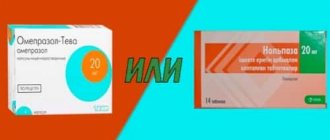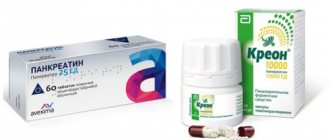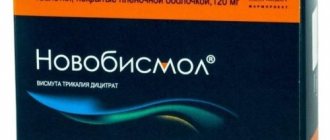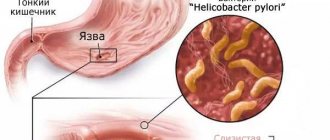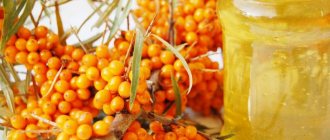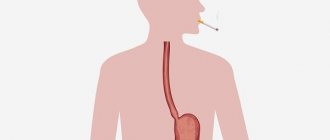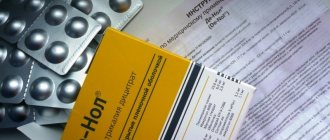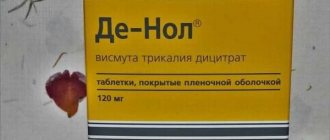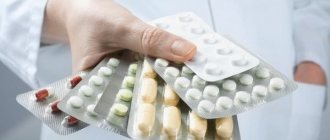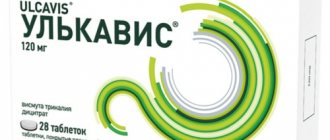Functions of gastroprotectors
Gastroprotectors are special medications designed to protect the delicate gastric mucosa from the effects of:
- Pepsin.
- Hydrochloric acid and other aggressive compounds that can destroy the gastric mucosa.
Gastroprotectors are medications that are used for gastrointestinal diseases such as:
- Erosion of the esophagus and stomach.
- Stomach ulcer.
- Duodenal ulcer.
Gastroprotectors are drugs that:
- Increases the resistance of the mucous membrane to environmental influences.
- Mechanically protect the mucous membrane.
- At the same time, they protect the esophagus, stomach and intestines and increase the resistance of the mucous membrane to environmental influences.
The peculiarity of gastroprotectors is that they are created on the basis of natural preparations, without chemicals, which provides effective protection without harming other organs or causing allergic reactions.
The list of gastroprotective drugs is quite long. Below are the most popular ones.
Which doctor should I contact?
Gastroprotectors have many positive characteristics. They help restore damaged mucous membranes. They are used in complex therapy, one-time, to eliminate unpleasant symptoms in acid-related diseases of the gastrointestinal tract. They have a lot of side effects, so they are prescribed by a doctor, indicating the dosage and method of use. Before using them, you should contact a gastroenterologist, who will prescribe a diagnosis and, if necessary, include gastroprotectors in the treatment regimen.
Rating: (votes - 1 , average: 5.00 out of 5)
"Ventrisol"
It is used for people suffering from gastritis, stomach ulcers, inflammation of the duodenal mucosa. Accelerates the healing process of affected areas of the gastrointestinal tract. Envelops only ulcerated areas of the stomach or duodenum. The price of Ventrisol is acceptable; it is an inexpensive drug.
Together with proteins formed from tissues lacking epithelium, the drug forms a substance that cannot be dissolved. It fills the affected areas of the stomach and protects it from the destructive effects of acid. Allows damaged tissues to recover. Available in tablet form. The price of Ventrisol is approximately 150 rubles.
It should not be used by pregnant women or mothers breastfeeding.
"Neointestopan"
The drug has an adsorbing and enveloping effect. Brings intestinal flora back to normal. Covers the stomach and duodenum with a thin film. Reduces intestinal spasms and has a positive effect on the irritated gastric mucosa.
Thickens the intestinal contents and improves stool consistency. It is used for food allergies and acute diarrhea caused by food poisoning, as well as for intestinal microflora disorders.
Contraindicated in children under 3 years of age, and pregnant women should use with caution. Side effects include constipation.
You can take the medicine for no more than two days. Available in tablet form.
Analogues of "Neointestopan": "Neostopan", "Kapekt", "Reaban".
Gastroprotective activity of glutamyl-tryptophan and melatonin dipeptide analogues
In experiments on male rats, the gastroprotective effect of synthetic dipeptides glutamyl-tryptophan (EW), isovaleroyl-glutamyl-tryptophan (ivEW), nicotinoyl-glutamyl-tryptophan (nEW) and melatonin when administered orally was studied in models of stress and indomethacin gastric ulcers. It was established that EW and melatonin have gastroprotective activity when used prophylactically in a model of stress gastric ulcer, and ivEW, nEW, EW and melatonin - when used therapeutically in a model of gastric ulcer caused by the administration of indomethacin. ivEW had the maximum gastroprotective effect when used in a therapeutic regimen. The therapeutic effectiveness of the drugs is based on their cytoprotective, antioxidant and immunomodulatory effects.
INTRODUCTION
Gastropathy, peptic ulcer of the stomach and duodenum (PUD), hyperacid and stress gastritis are widespread among the working population, which explains the great medical and social significance of the problem [1]. The complexity of the problem lies in the fact that, despite the use of effective methods of treating DU, relapses occur in 60-100% of cases. Polypharmacy, along with stress, causes an additional locally irritating and altering effect on the gastrointestinal tract in elderly patients (the use of NSAIDs for the treatment of diseases of the musculoskeletal system, etc.).
Basic pharmacotherapy for gastropathy includes the following groups of drugs: histamine receptor and proton pump blockers, antacids; anti-helicobacter drugs; gastroprotectors [2].
Due to the fact that pharmacotherapy of DU presents considerable difficulties, the search for drugs that are more advanced in their mechanism of action and clinical results can only be fruitful taking into account the accumulated information about the pathogenetic mechanisms of the disease, as well as long-term experience in using drugs in the clinic. The ideal solution is to create drugs with systemic and local gastroprotective effects. Increasing the resistance of the gastric mucosa (GM) and duodenal mucosa (DMU) can be achieved through activation of the antioxidant system, normalization of the psychosomatic component, and sufficient provision of the body with nutrient factors [1,3]. An important role is played by the regulation of the work of three vital and interconnected systems: nervous, immune and endocrine [4]. In recent years, a new direction in the treatment of ulcerative-erosive lesions of the gastrointestinal tract with natural (flavonoids, phenolic compounds) and synthetic (probucol, etc.) antioxidants has emerged in medical practice, which is due to their positive effect on “oxidative” stress [1, 3]. The role of the immune system in the implementation of gastroprotective effects of synthetic analogues of thymus and melatonin peptides is being studied [5-7].
The present study aimed to evaluate the effectiveness of orally administered glutamyl-tryptophan (EW), EW analogues: isovaleroyl-glutamyl-tryptophan (ivEW), nicotinoyl-glutamyl-tryptophan (nEW) and melatonin in experimental gastric ulcers induced by stress and indomethacin, in comparison with gastroprotectors misoprostol and sucralfate.
RESEARCH METHODS
Experiments were carried out on 274 outbred male Sprague-Dawley rats weighing 180–200 g, raised in the Rappolovo nursery of the Russian Academy of Sciences. Before experiments, animals were subjected to 14-day quarantine and randomization. The animals were kept in a vivarium on a standard diet. The experiments were performed according to the requirements of the ethics committee [8, 9].
Two variants of gastropathy were modeled: stress gastric ulcer according to Selye and ulceration with the administration of indomethacin. 24 hours before stress or application of an ulcerogen, animals were deprived of food with free access to water, since fasting due to the activation of anaerobic glycolysis helps to reduce the level of protective factors in the gastric mucosa. Ulcer formation was modeled according to Selye: animals were immobilized in plexiglass cases at a temperature of 4 °C for 3 hours. An ulcerogenic dose of indomethacin (10 mg/kg) was administered intramuscularly over three consecutive days in a sterile pyrogen-free saline solution [10, 11]. Peptides and comparison drugs in the effective doses indicated below were injected into the stomach 1 hour and 7 days before modeling a stress ulcer according to Selye (preventive regimen) or injected into the stomach within 7 days from the moment of modeling an indomethacin gastric ulcer (therapeutic regimen). Animals in the control group received equivolume amounts of solvent in the appropriate modes.
In each series, the following experimental groups of 10–12 animals were formed: 1 — intact rats; 2 - animals with pathology that received saline solution (control); 3 - animals with pathology who received a comparison drug (misoprostol, sucralfate); 4 - animals with pathology that received melatonin or one of the studied peptides. Based on an analysis of literature data [1 – 3, 5-7], the following doses of drugs were selected for the study: EW-0.1; 1 and 10 mcg/kg; melatonin - 0.3 and 3 mg/kg; misoprostol - 50 mcg/kg; sucralfate - 200 mg/kg. Synthetic peptides ivEW and nEW were tested at EW-relevant doses.
At the end of immobilization according to Selye and experimental therapy, the animals were killed [9] by instant decapitation, the stomachs were removed, opened along the greater curvature, washed with physiological solution, and the number of destructions was determined macroscopically under bright vertical lighting, which were differentiated by their surface area into small ones (M) with a diameter of less than 1 mm, medium (C) round and strip-shaped from 1 mm and large (K) more than 1-2 mm. The size of coolant destruction was determined using a digital microscope “Expert Prima” (LOMO, Russia). The presence of blood at the bottom of the destruction was detected in a peroxidase reaction with the substrate orthodianisidine hydroperoxide with tinting of the mucous membrane with methylene blue. In this case, the heme-containing surface turned brown-black against the bluish background of the intact mucosa.
The distribution of animals in the group with mucosal defects was taken into account according to the severity of macroscopic changes, the Pauls index (PI) was calculated using the formula: (average number of ulcers x % of animals with ulcers)/100% and gastroprotective activity (GA): ratio of PI in the control group to IP in the experimental group. The study drug was considered active if the GA was 2 or more units. Biochemically, the level of malondialdehyde (MDA), glutathione and myeloperoxidase (MPO) activity in 10% homogenates of the coolant was assessed using standard methods [12 – 14]. For histological examination, sections of the stomach wall were fixed in a 10% formalin solution 2 hours after taking samples and complete relaxation of the smooth muscles. Sections were stained with hematoxylin-eosin. Microscopic examination of stomach wall preparations was carried out using a B-350 microscope (Optika, Italy).
Statistical processing was carried out using Excel and Statistica 6.0 programs. The results in the tables were presented as M + a. Differences between groups were assessed using nonparametric analysis of variance criteria in accordance with the instructions for data processing programs and were considered significant at p < 0.05.
RESULTS AND ITS DISCUSSION
EW and melatonin were previously shown to have stress-protective properties [5 – 7]. In this regard, at the first stage of the experiment, their gastroprotective activity was studied using Selye’s stress ulcer model. After immobilization of animals in the cold, the following pathological changes occurred in the gastric mucosa: the development of hyperemia, paresis and dilatation of the gastric muscles, the formation of erosions and ulcers, bile reflux and fibrinous plaque.
EW, melatonin and the comparator drug misoprostol, when administered prophylactically, exhibited gastroprotective activity to varying degrees. The results are presented in table. 1.
Table 1. Effect of EW and melatonin on ulceration under Selye stress (n = 10)
Note. * — differences are significant compared to control at p < 0.05; ** - positive differences are significant compared to misoprostol at p < 0.05. M - melatonin; K - large ulcers, C - medium ulcers, M - small ulcers; PI - Pauls index, GA - gastroprotective activity.
With a single administration, melatonin had moderate gastroprotective activity (3 mg/kg; GA = 2). It provided a reduction in the number of ulcerative defects of the coolant of medium (2 times) and small (1.9 times) sizes. A dose dependence of the gastroprotective effect of melatonin was noted. However, the effect of melatonin was significantly inferior to that of misoprostol. EW, when administered once to rats, did not have gastroprotective activity and did not reduce the number of animals with ulcerative defects.
A seven-day prophylactic course of melatonin had a sufficient gastroprotective effect (GA = 3), slightly different from that with a single administration of this hormone. At a dose of 3 mg/kg, melatonin reduced the number of destructions of the coolant: large ulcers were practically absent, and the number of medium and small ones was significantly lower than in the control group of animals. The data obtained confirm the role of melatonin in the development and limitation of the stress response and somatic pathology [5, 15].
Analysis of the data obtained showed that prophylactic administration of EW to rats during the week before stress had a gastroprotective effect comparable to that of misoprostol, and when administered at a dose of 1 μg/kg, superior to that. EW had the maximum gastroprotective activity (at a dose of 0.1 μg/kg GA = 27; at a dose of 1 μg/kg GA = 50), surpassing the effects of misoprostol and melatonin. The identified gastroprotective properties of EW, which differ from those of melatonin, as well as the fact that gastroprotective activity was not detected for EW after a single administration, indicate the participation of the immune and antioxidant systems in the implementation of the gastroprotective effect of this peptide with repeated use.
In connection with the revealed pronounced gastroprotective activity of EW when used prophylactically, in the next series, an extensive study of the effectiveness of this dipeptide and its modified analogues when used therapeutically in a model of indomethacin gastric ulcer was carried out.
It has been established that modeling a gastric ulcer by administering indomethacin at an upcerogenic dose is accompanied by the development of significant pathological changes in rats after 3 days from the moment of priming. On the 7th day, the animals lost up to 30% of their body weight from the background values, which was associated both with blood loss as a result of gastric bleeding and with increased catabolism. All animals from the control group showed pronounced hyperemia and the appearance of destruction in the gastric mucosa: a significant number of superficial and deep erosions and swelling of the near-erosive surface. At the bottom of most destructions, the presence of heme-positive material was revealed (blood: hematin and methemoglobin due to hemorrhage of exposed submucosal capillaries and oxidation of hemoglobin by hydrochloric acid of gastric juice). A significant decrease in body weight was noted in the following cases of drug use: in the control, with the introduction of EW and nEW at a dose of 10 μg/kg - in 100% of animals in the group. ivEW at a dose of 0.1 μg/kg had the greatest protective effect; EW and nEW, administered at a dose of 0.1 μg/kg, were comparable in this indicator. With the introduction of sucralfate, there was a significant decrease in both the number and area of ulcerative defects. Mucosal hyperemia was noted in 40% of animals.
The results of assessing the effect of the studied drugs on the amount of destruction in the gastric mucosa of animals are presented in Table. 2.
Table 2. Effect of modified EW analogues on the process of ulcer formation in animals using a model of indomethacin gastric ulcer (n = 12)
Note. * — differences are significant compared to control at p < 0.05; ** - positive differences are significant compared to sucralfate at p < 0.05. M - melatonin; K - large ulcers, C - medium ulcers, M - small ulcers; PI - Pauls index, GA - gastroprotective activity.
Administration of EW in various doses into the stomach prevented the formation of gastric ulcers. This effect was more pronounced when administered at a dose of 0.1 mcg/kg, both in the total number of gastric ulcers and in the number of rats with ulcers. At a dose of 10 mcg/kg, the drug significantly reduced the number of large destructions and had no effect on the number of medium and small ulcers. Melatonin was similar in effectiveness to EW, but less significantly.
The ivEW peptide had pronounced gastroprotective properties. Against the background of its administration, there was a decrease in the Pauls index compared to the control and comparison drug (p < 0.05). At a dose of 10 mcg/kg, it is comparable to the activity of EW in reducing the average number of destructions, and in gastroprotective activity it was superior to the effect of sucralfate and other drugs. The nEW peptide, which was comparable to EW in a number of indicators, was superior to sucralfate in GA.
The content of peroxidation products in the coolant and the activity of myeloperoxidase during peptide therapy significantly decreased, and the level of glutathione increased. The established positive changes in relation to the biochemical indicators of the functioning of the coolant under the influence of experimental drug therapy characterize the contribution of the antioxidant system to the implementation of the gastroprotective properties of the selected compounds [6, 7]. The results are presented in table. 3.
Table 3. Effect of modified EW analogues on biochemical parameters of the gastric mucosa during ulcer formation in animals using a model of indomethacin gastric ulcer (n = 12)
Note. l — differences are significant compared to the group of intact rats at p < 0.05; * — differences are significant compared to control at p < 0.05; ** - positive differences are significant compared to sucralfate at p < 0.05. M - melatonin; MDA - malondialdehyde, MPO - myeloperoxidase
In the control, there was a significant increase in the level of MDA by 2.9 times, the activity of myeloperoxidase increased by 1.9 times, and the level of glutathione decreased by 2.1 times compared to intact rats (p < 0.05). This indicated acceleration of the processes of free radical oxidation and depletion of the pool of antioxidants (due to inhibition of the synthesis of protective factors), as well as the influx of polymorphonuclear leukocytes activated by the chloride environment, which led to an increase in the activity of myeloperoxidase.
Sucralfate reduced the level of lipid peroxidation products by 1.6 times compared to the control, MPO activity by 1.5 times, and restored the reduced concentration of glutathione by 1.3 times, mainly due to binding and adsorption processes on the surface of the coolant. EW was close in activity to sucralfate: upon its administration, the MDA level decreased by 2.2 times (0.1 μg/kg), and the effect on MPO and glutathione levels was comparable to sucralfate (0.1 μg/kg). However, this probably occurred through a different mechanism than the effect of the reference drug. At a dose of 10 μg/kg, EW was slightly inferior to the effect of sucralfate.
The greatest positive changes were noted in rats receiving the ivEW peptide. Thus, when administered at a dose of 0.1 μg/kg, a significant normalization of lipid peroxidation processes and myeloperoxidase activity, and restoration of glutathione levels were noted (p < 0.05). But the glutathione content in the coolant homogenate did not reach the values of intact animals. The activity of the ivEW peptide was significantly superior to EW, nEW, melatonin and sucralfate.
Microscopy of stained sections of the stomach walls of rats revealed pathological changes in the mucous membrane. In the control group, the presence of deep ulcerative defects with exposure of the muscular plate, shallow ulcers (down to the glandular epithelium), and many superficial erosions were noted. In animals receiving sucralfate, the absence of deep ulcerative defects and a small number of superficial erosions were noted. Melatonin therapy led to a decrease in the number of ulcers, but the depth of these ulcers was similar to those detected in the control group. EW had a more significant positive effect on the processes of damage to the coolant than melatonin. In groups of rats treated with ivEW and nEW peptides, minimal pathological changes in the coolant were recorded, mainly due to superficial erosions and pinpoint areas of epithelial necrosis.
Based on the magnitude of gastroprotective activity in the model of indomethacin gastric ulcer with a therapeutic administration regimen, the studied substances can be arranged in the following row in order from the most active compound to the least active: ivEW > nEW > EW “melatonin.
CONCLUSIONS
- Glutamyl-tryptophan dipeptide does not have a gastroprotective effect after a single prophylactic use in a stress ulcer model. When administered seven times as a prophylactic measure to rats, EW causes a significant reduction in the number of ulcerative destructions in the stomach of rats subjected to immobilization stress according to Selye, which significantly differs from melatonin.
- Glutamyl-tryptophan, isovaleroyl-glutamyl-tryptophan, nicotinoyl-glutamyl-tryptophan and melatonin have a gastroprotective effect, expressed to varying degrees in the model of indomethacin gastric ulcer in rats.
- Isovaleroyl-glutamyl-tryptophan has the greatest gastroprotective activity when taking a cyclooxygenase inhibitor compared to other drugs. During experimental therapy with the peptide, there was a significant increase in the content of antioxidants and a decrease in the intensity of lipid peroxidation processes in the gastric mucosa.
Literature:
- V. G. Podoprigorova, Oxidative stress and peptic ulcer disease, Moscow (2004).
- Register of Medicines of Russia, Encyclopedia of Medicines - 12th issue, Moscow (2005).
- V. N. Shatalov, D. B. Korman, T. V. Krutova et al., Pharmacol. i Toksikol., 3, 60 – 63 (1988).
- E. E. Lesiovskaya, Metaprot under extreme influences, St. Petersburg. (2010).
- T. V. Kvetnaya, I. V. Knyazkin, Melatonin: role and significance in age-related pathology, VMedA, St. Petersburg (2003).
- RU2213571, 30.11.2001, p. 6, left column O. V. Filippova, D. V. Zolotarev, E. L. Karpova, Antihypoxic agent (thymogen) (2001).
- Clinical pharmacology of thymogen, V. S. Smirnov (ed.), St. Petersburg. (2003).
- Public Health Service on Human Care and Use of Laboratory Animals. Washington. — DC: US Department of Health and Human Services, 28 (1996).
- Report of the AVMA panel on euthanasia, American Veterinary Medical Association, 202(2), 229 – 249 (1993).
- G. Derelanko, G. T. Long, Digestive Diseases and Science, 25(11), 830-838 (1980).
- F. P. Trinus, N. A. Mokhort, B. M. Klebanov, Nonsteroidal anti-inflammatory drugs, Health, Kyiv (1975).
- Medical laboratory technologies. Handbook, A.I. Karpishchenko (ed.), Intermedica, St. Petersburg (2002).
- Aykac, M. Uysal, A. S. Yalcin, et al., Toxicology, 36, 71 – 76 (1985).
- P. Bradley, D. A. Priebat, R. D. Christerser, G. Rothstein, J. Invest. Dermatol., 78, 206 – 109 (1982).
- Melchiorri, E. Sewerynek, R. J. Reiter, et al., Br. J. Pharmacol., 121, 264 – 70 (1997).
"De-Nol"
This drug protects the mucous membrane and tissues of the stomach, and also neutralizes the aggressive environment. Refers to bacterial agents. The drug is capable of destroying microbial cells. The drug affects the stomach and duodenum. Prevents the development of peptic ulcers. In the stomach it becomes a colloidal solution. Thanks to this, the mucous membrane is protected from the effects of gastric juice.
The drug restores damaged stomach tissue. It has a comprehensive effect on problems in the intestines and stomach. It has an astringent, antiseptic, antibacterial and healing effect. The drug is available in tablet form.
Indications for use of the drug "De-Nol" are as follows:
- stomach and duodenal ulcers;
- chronic gastritis;
- dyspepsia and diarrhea;
- irritable bowel syndrome.
Gastroprotectors for gastritis of the stomach
Gastroprotectors provide direct protection of the gastric mucosa. During an acute attack of gastritis, such drugs protect the epithelial tissues of the stomach walls from the aggressive effects of chemicals (acids, alkalis, etc.). Bismuth preparations have several pronounced effects: gastrocytoprotective, antiulcer and antibacterial.
A type of gastroprotector are prostaglandin derivatives, for example, Misoprostol. The drug increases the protective properties of gastric epithelial tissues and their resistance to external influences. Epithelial cells synthesize prostaglandin, which is involved in the normal functioning of the gastric mucosa.
Prostaglandin derivatives are effective for gastritis caused by long-term use of NSAIDs (aspirin, paracetamol, etc.). In case of chemical or drug-induced gastritis, it is quite advisable to treat the disease with such drugs. A side effect that limits the use of Misoprostol is frequent diarrhea.
A type of gastroprotector are prostaglandin derivatives, for example Misoprostol
The following drugs are often used:
- De-Nol: in addition to the protective effect, it has high activity against Helicobacter pylori infection. When interacting with gastric acid, a protective film is created that mechanically protects the gastric walls, especially in areas of ulceration;
- Venter (Sucralfate): contains aluminum and sucrose, which, when exposed to the acidic environment of the stomach, form a stable polymer that protects mucous tissues. The resulting film adheres to the gastric walls and creates a coating that protects against the action of aggressive irritants. It is not recommended to take this drug if you have low stomach acid or at the same time as antacids.
Treatment of chronic gastritis with gastroprotectors
Chronic gastritis must be treated with gastroprotectors. Protective drugs are: Venter; De-Nol; Biogastron; Hilak-Forte.
Medicines that restore the gastric mucosa have an enveloping effect, therefore they are prescribed for the treatment of acute gastritis. Gastroprotectors protect the digestive organs from bacteria, infections, toxins, and help normalize the intestinal microflora due to their effect on pathogenic substances. For acute and chronic gastritis, you can use gels or suspensions (Almagel, Phosphalugel) to prevent damage to the mucous membrane and relieve symptoms (heartburn, pain syndromes).
"Ulgastran"
Belongs to the same pharmacological group. It is used for stomach and duodenal ulcers, inflammation of the mucous membrane and various types of gastritis. Protects the gastric mucosa from acids. Forms a protective film on damaged areas of the stomach and duodenum. Allows the binding of bile acid and pepsin.
Acts as an analgesic and helps speed up the recovery of damaged areas of the stomach and duodenum. Contains aluminum salt. Reduces pepsin activity and increases the production of prostaglandins. When dissolved in an acidic environment, it forms a sticky mass with unusual properties. Creates a barrier that protects damaged areas of the stomach.
Available in tablet form.
"Sukrat"
Mechanism of action of the gastroprotector: has a protective effect on the mucous membrane of the stomach and intestines. Available in the form of tablets, in a package - 10 pieces.
This gastroprotector drug, interacting with the proteins of necrotic ulcer tissue, creates protective layers that help prevent the subsequent destructive effects of pepsin, hydrochloric acid and bile salt. Helps increase prostaglandin synthesis, reduces the active effects of pepsin and binds bile acid salts. Inhibits the active activity of pepsin by 30%. Gives a weak antacid effect.
How to be properly treated with gastroprotectors
Alkaline acids contained in food can damage the gastric mucosa. To protect it, there are special medications - gastroprotectors. These drugs are divided into 2 large groups, which differ in their principle of action. The first is film-forming drugs. The second is drugs that increase the physiological ability of the gastrointestinal tract to resist harmful substances. All these drugs are used for the treatment and prevention of gastritis, ulcers, and erosions.
If the first group of gastroprotectors temporarily protects the gastrointestinal mucosa, the second group provides a protective effect by the body itself. One of these medications is the drug Rebamipide, which increases the content of natural mucus on the internal walls of the organ. This prevents their damage, since acids and alkalis cannot have the direct effect that is observed with a lack of mucous layer. The choice of medication depends on the presence of the disease and its stage.
As a preventive measure, gastroprotectors of this group work more effectively than drugs that form a protective film. However, in case of exacerbation of the disease, manifested by pain and burning, it is better to use drugs of the 1st group (film-forming) as an “ambulance”.
Indications for taking gastroprotectors of group 2, including Rebamipide:
- prevention and treatment of non-exacerbated forms of gastrointestinal ulcers, erosion,
- in the stomach there is a constant increased secretion of hydrochloric acid,
- gastritis (chronic, erosive) due to increased acid formation,
- as a prevention against damage to the inner lining of the gastrointestinal tract if non-steroidal anti-inflammatory drugs are taken.
It should be noted that taking Rebamipide requires strict adherence to the instructions. Tablets should be taken one three times a day. The duration of the course is 4-8 weeks.
Sources:
- https://www.kp.ru/guide/lekarstvo-ot-gastrita.html
- https://excelion.ru/raznoe-2/gastroprotektory-preparaty-spisok-gastroprotektory-spisok-i-xarakteristiki.html
- https://poznayka.org/s63155t1.html
- https://xn--90ad9d.xn--p1ai/lekarstva-i-preparaty/kakie-prinimat-tabletki-ot-gastrita.html
- https://gastritinform.ru/medlistok.com/papers6/kak-pravilno-ljechitsja-gastroprotjektorami.asp
"Kaopectate"
The gastroprotector medication belongs to the antidiarrheal pharmacological group. The effect of the drug is to adsorb toxins, bacteria and gases while normalizing the composition of the intestinal flora. Thanks to its astringent effect, it relieves irritation of the intestinal mucosa and relieves spasms.
The medical drug "Kaopectate" is actively used for the following gastrointestinal dysfunctions:
- acute diarrhea of various origins (infectious, allergic, medicinal);
- toxic infections;
- diseases associated with disturbances in the intestinal microflora.
The drug "Kaopectat" is not prescribed to children under 3 years of age, to children from 3 to 6 - with caution. Contraindications for prescribing the drug may include hypersensitivity and fever.
Constipation is noted as a side effect, and various allergic reactions may occur.
Contraindications and side effects
Gastroprotectors are contraindicated for:
- pregnancy and lactation;
- severe renal failure;
- individual intolerance/hypersensitivity to drugs;
- liver dysfunction.
During the therapeutic course, side effects rarely occur in patients. Meet:
- nausea, vomiting;
- stool disorders;
- allergic reactions.
Along with Omeprazole and other proton pump blockers, gastroprotectors are included in most classical gastritis treatment regimens. Their course intake, as well as strict adherence to other doctor’s recommendations, will activate the regenerative abilities of the mucous membrane and alleviate the course of the disease.
"Venter"
"Venter" is a medical product from the pharmacological group of gastroprotectors. This drug has an antiulcer effect. The effect is achieved due to the formation of a protective layer on the mucous membrane, which counteracts the destructive effect of gastric hydrochloric acid or bile salts on the stomach.
The drug "Venter" is actively prescribed for stomach or duodenal ulcers. The drug has low absorption, 90% of its primary composition is excreted through the intestines, a small percentage can be excreted through the kidneys.
The drug "Venter" should be used by pregnant women and during breastfeeding with caution and under the supervision of a physician.
Contraindications for prescribing the drug are: hypersensitivity, kidney disease, obstruction and bleeding in the gastrointestinal tract.
Possible side effects: constipation, nausea, dry mouth, slight drowsiness, mild itching.
"Ankrusal"
"Ankrusal" is a medical drug from the pharmacological group of gastroprotectors, the main substance of which has a therapeutic effect is sucrolfate.
The pharmacological effect of the drug is the formation of a protective layer on the walls inside the stomach and the absorption of bile salts. "Ankrusal" is used during the course prescribed by the doctor for diseases of the digestive tract and metabolic pathologies:
- stomach ulcers or duodenal ulcers;
- peptic ulcers of unknown localization;
- clinical conditions resulting from acidity disorders;
- gastroesophageal reflux;
- certain diseases of the urinary system (hyperphosphatemia with uremia).
The drug "Ankrusal" is contraindicated in case of hypersensitivity, gastrointestinal obstruction, gastrointestinal bleeding, as well as in pregnant women.
It should be noted that the drug is poorly absorbed, does not accumulate in tissues, and part of the drug taken (95-97%) is excreted in the feces. Constipation is reported as a side effect.
"Alsukral"
Also included in the list of gastroprotector drugs. Refers to a type of film-forming agent, used for people suffering from stomach ulcers.
Forms a protective layer in the form of a film, reduces the effects of pepsin and increases the production of Pg. When dissolved in an acidic environment, the drug turns into a sticky mass endowed with alkaline qualities. In the stomach it is converted into a polyanion with negative charges.
Protects damaged areas of the mucous membrane. It also protects the mucous membrane from exposure to aggressive substances. It interacts weakly with the mucous membrane, thus enhancing the protection of the mucous membrane and allowing it to protect against the action of substances such as bile.
Classification
In the classification of gastroprotectors, there are five groups of agents:
- Film-forming agents – bismuth preparations, Sucralfate.
- Enveloping and adsorbing – Simaldrat.
- Cytoprotectors – Misoprostol.
- Regeneration stimulants – Methyluracil, Etaden, Pentoxyl, biogenic stimulants.
- Activators of mucus secretion - cabbage juice, licorice root preparations.
Film-forming agents
After entering the stomach, colloidal bismuth preparations form a glycoprotein-bismuth complex, which is concentrated mainly in the area of mucosal defects. In this way, a strong protective barrier is formed, which not only prevents further damage, but also accelerates the healing of the mucosa. In the treatment of gastritis and peptic ulcer of Helicobacter pylori etiology, the inhibitory effect of bismuth on Helicobacter pylori is also important.
Sucralfate is a complex disaccharide that contains aluminum. When taken orally, it is practically not absorbed into the blood, and when it enters the stomach it polymerizes, forming strong bonds with the mucous membrane in the area of erosions and ulcers. Such a strong protective layer remains in the stomach for up to 8 hours, in the duodenum for up to 4 hours. Unlike antacids, Sucralfate inhibits the enzymatic activity of gastric juice slightly - no more than 30%.
Enveloping drugs
Simaldrate is able to neutralize excess HCl in the stomach. It has the following pharmacological properties:
- adsorbent;
- enveloping;
- antacid;
- cytoprotective.
When interacting with gastric juice, the active substance forms silicic acid. It provides a high buffering effect and promotes the formation of a protective film on the mucous epithelium. The duration of the therapeutic effect is 2-4 hours.
Cytoprotective drugs
Misoprostol is a synthetic analogue of prostaglandin E1. Its mechanism of action is based on:
- decreased HCl production;
- reduction of peptic activity of gastric juice;
- limitation of vascular permeability;
- normalization of microcirculation;
- increased secretion of mucus and bicarbonates.
In addition, the gastroprotective properties of misoprostol tablets are associated with the prevention of damage to the stomach walls when exposed to aggressive factors.
Regeneration stimulants
Regeneration stimulants are the most extensive group of gastroprotectors. Below is a list of drugs with proven effectiveness:
- Methyluracil - stimulates the synthesis of protein molecules, accelerates regeneration and restoration processes in cells.
- Nandrolone, Methandienone – anabolic steroids; also stimulate protein production and promote rapid healing of ulcerative defects. Indicated for malnourished patients with widespread inflammatory lesions of the stomach and duodenum.
- Solcoseryl, a calf blood extract, is a biogenic stimulant.
- Aloe, royal jelly, Kalanchoe, propolis are general strengthening agents.
- Rosehip oil, sea buckthorn oil – antioxidants, sources of vitamins E, C, folic acid, etc.
Mucus production stimulants
Licorice root contains the maximum amount of active components - licuracid, livirton, essential oils. They have an antispasmodic, anti-inflammatory, restorative effect on body tissues.
